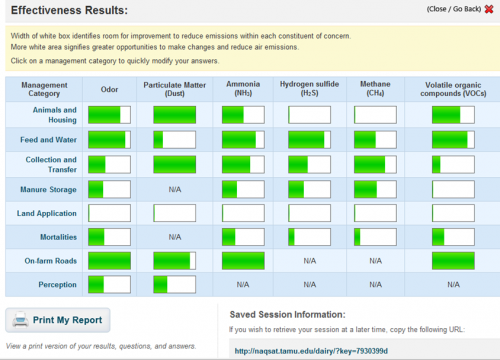Evaluating livestock air emission using the National Air Quality Site Assessment Tool
NAQSAT helps livestock farmers identify opportunities to reduce air emissions associated with their farms.
An Environmental Protection Agency (EPA) Science Advisory Board recently appointed a panel of experts to review the National Air Emissions Monitoring Study (NAEMS). This panel will review the study along with other applicable research results and make comment on EPA’s draft air emission estimating methodologies for livestock and poultry farms. Now is an excellent time to model the current status of a livestock or poultry farm’s air emissions, prior to the implementation of any new reporting requirements associated with the NAEMS results. Producers who may be either concerned or interested in the air emissions associated with their farms may want to spend a small amount of time evaluating their operation using the National Air Quality Site Assessment Tool (NAQSAT).
NAQSAT is an online program developed to evaluate the odors and air emissions from livestock and poultry operations. The tool is applicable across all types of housing and manure management systems for beef, swine, dairy, turkeys, broilers and layers. Information entered while using the tool remains confidential and there is nothing entered into the program that would identify the inputs or results page back to the producer or location.
Additional advantages to using NAQSAT include:
- Providing a confidential assessment for their farm on the effectiveness of current management practices impacting odor levels and air emissions
- The opportunity to run different alternative scenarios to determine the effectiveness of new emission reduction practices
- Determining the possible unintended consequences of proposed new management practices prior to their installation
Entering the farm’s information into NAQSAT is user friendly and will not require extensive data gathering for the producer, farm manager or farm consultant. After logging into the site and selecting the species of interest, the user is asked a series of questions under eight management categories: animals and housing, feed and water, manure collection and transfer, manure storage, land application, mortalities, on farm roads and perception. When a visual interpretation of the existing or proposed management practices is helpful, pictures are provided to help users select the conditions that best exemplifies the current situation.
After completing an initial analysis of the farm’s current status, additional scenarios may be run to determine the effectiveness of improved or changed management practices.
The results illustrate the farm’s performance for six emissions of concern: odor, particulate matter (dust), ammonia (NH3), hydrogen sulfide (H2S), methane (CH4) and volatile organic compounds (VOCs) in each management category. Using bar graphs with the user can see where the greatest opportunity exists for reducing emissions through improved management. In the Effectiveness Results page for a sample farm provided below, the green area in each bar indicates how effectively the farm is reducing emissions within each management category. The white area in each bar indicates opportunity for continued improvement. In the sample below, if the farm management was looking for opportunities to reduce odors they would be most interested in the current management practices in land application, collection and transfer, manure storage and perception. Given the amount of green in each bar for animals and housing, and feed and water there would be a smaller benefit from additional odor control practices in those categories. Obviously, based on the remaining white area in the bars for land application, improved application practices have the potential to reduce all six emissions of concern.

NAQSAT is available for online use and the program will not download on to the user’s computer. All inputs along with the effectiveness result page will be saved at the NAQSAT site. After inputting the farm’s information users may select “Save progress.” A new URL will be propagated by the program and appear on the screen. Information entered within this unique URL will remain available for changes and review for 60 days. NAQSAT users are encouraged to bookmark each scenario’s URL so they may easily return to it if the need arises.
The United States Department of Agriculture Natural Resources Conservation Service (USDA-NRCS) Conservation Innovation Grant program partially funded development of NAQSAT. Thanks to a partnership with the Livestock and Poultry Environmental (LPE) Learning Center, beef and dairy producers can learn how to use the tool in a webcast found at the eXtension beef and dairy website. Swine and poultry producers may find a similar webcast at the eXtension swine and poultry website.



 Print
Print Email
Email



